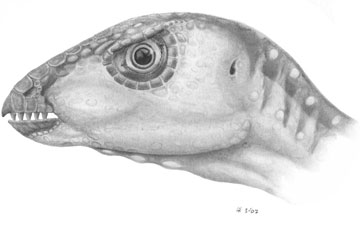Newly discovered burrowing dinosaur loved its offspring
Newly discovered burrowing dinosaur loved its offspring
mongabay.com
March 20, 2007
The first known burrowing dinosaur has been discovered in southwest Montana, according to a paleontologist at Montana State University. The finding, published in the journal Proceedings of The Royal Society B: Biological Sciences, may shed light on parental care among dinosaurs as well as fuel controversy over what caused the extinction of the prehistoric beasts.
The 95 million-year-old fossil remains of Oryctodromeus cubicularis suggest the nearly seven-foot-long lizard raised its young in burrows and would have been capable of surviving in some of the world’s harshest environments, calling into question whether an asteroid truly caused the demise of dinosaurs.
“The presence of an adult and two juveniles within a denning chamber represents some of the best evidence for dinosaur parental care,” said Montana State University paleontologist David Varricchio, lead author of the study. “The burrow likely protected the adult and young Oryctodromeus from predators and harsh environmental conditions. Burrowing behavior may have allowed other dinosaurs to survive in extreme environments such as polar regions and deserts and questions some end-Cretaceous extinction hypotheses.”
 An artist’s illustration of an Oryctodromeus head. (Illustration by Lee Hall).
|
Prevailing theory holds that the Cretaceous-Tertiary extinction some 65.5 million years ago was triggered by the impact of a large asteroid which stuck Earth near the coast of the Yucatan Peninsula in Mexico. The impact would have caused catastrophic changes in Earth’s atmosphere that could well have led to the extinction of most of the planet’s largest life forms. However, it is thought that burrowing animals, like rodents and smaller reptiles would have survived the impact. The existence of a burrowing dinosaur suggests the possibility that some species would have survived past the Cretaceous age, but only if they still had access to food sources. Because the newly discovered Oryctodromeus cubicularis was an herbivore, it seems unlikely that it would have survived much after the impact despite its burrowing nature.
“Survivability of terrestrial vertebrates at the end- Cretaceous event has been attributed to sheltering behaviour, with the extinction of non-avian dinosaurs resulting from their inability to find an appropriate cover,” the Scotsman quoted Varricchio as saying. “Burrowing dinosaurs would challenge this argument, but these are yet to be found in the latest Cretaceous formations.”
CITATION: David J. Varricchio, Anthony J. Martin, Yoshihiro Katsura (2007). First trace and body fossil evidence of a burrowing, denning dinosaur.
Proceedings of the Royal Society B: Biological Sciences. ISSN: 0962-8452 (Paper) 1471-2954 (Online) Issue: FirstCite Early Online Publishing. DOI: 10.1098/rspb.2006.0443
